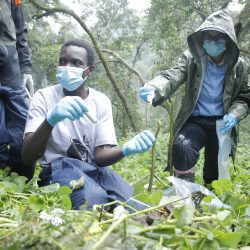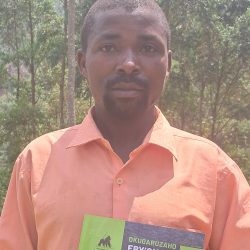The Dividends of Peace in a Stunning Landscape
Blog | 27/10/09
All we had to do was follow the dung. It was fresh, and we found piles of it about every 100 meters. A pile here under the crowded bamboo stands, another one there tucked underneath a tangle of wild celery, nettles and vines. But then the dung started to climb, and each hill was getting steeper. As soon as we dragged ourselves up one, satisfied with our amateur mountaineering skills, another one presented itself. They were an ambitious lot this morning, and decided to take the hard way up the mountain. By the time we were close, we were pulling ourselves up almost vertical slippery slopes, grasping for exposed roots as anchors.
Finally a break. We struggle through a spongy carpet of wildflowers and plants that can prick the skin even through two layers of clothing. But at least it is flat. Another pile of dung, and our ranger and guide Phillip declares, “they are close”. No sooner do I pull out my camera when I hear a rustling. I look up and it’s a juvenile in a tree, stretching backward on the branches and hanging on for dear life, as if he or she were an acrobat high in the air completing a trick particularly precarious in its technicality. We have found the family Kabirizi.
Earlier, as I looked up to the massive pointy pyramid that is Mikeno Volcano, I could barely make out the peak, with the thick gray clouds that enveloped it refusing to budge. I spent a cold, rainy night in a small green tent at Bukima, the nearby ranger station. At 1 AM a small animal scratching the tent’s outside wall woke me up, but I was not about to let in my visitor. The rain was icy, and my coffin of a sleeping bag was too cozy to wriggle out of. I woke up in the chilly wet air praying the clouds, still ominous with bellyfuls of liquid, would take a break and spare our uphill trek. So far, so good: a few slivers of sun have now broken through the dense gray wall.
With peace growing as fast as the local crops of corn, beans, cabbage and potatoes sprouting from the rich volcanic soil surrounding Virunga National Park here in the Eastern Democratic Republic of Congo, both gorilla and human communities are thriving. Yesterday, as we negotiated mud and porous volcanic rock on the skinny road up to Bukima, IGCP DRC Programme Driver Jerome beamed, “look at these kids! They are healthy and happy. They go to school now.” Just a year before, he reminded me, a rebel army had paraded through this swathe of fertile land and compact villages, destroying everything but the bamboo groves. “Before there was nothing here, now there are potatoes, corn, beans….people can farm again and everyone is fed.” The dividends of peace are clearly visible.
The Kabirizi family is no doubt benefiting from these dividends as well. They must be healthy and well-fed, I am thinking, because after waking in the Volcano’s eerie early morning mist, they had the energy to climb several near vertical hills that just about knocked out this skinny, hairless ape (with bad knees). And they are still bubbling with that energy: we have to fend off a juvenile and the female sub-adult Masibo, who keep circling around in the brush, attempting to outwit us in a game of hide and seek. We dutifully don our face masks – so as to not pass any illnesses on – and keep the requisite distance of seven meters (about 21 feet), though it is challenge with their constant cat and mouse movement.
Where is Kabirizi, the 35 strong family’s head of the household and lone silverback? After 30 minutes we finally spot him, lazing under a stand of bamboo, not even giving us a passing glance. His family is safe, well-fed and full of energy, their “salad bowl” home an island of copious buffets and endless playgrounds. While Kabirizi lounges, the juveniles climb and tumble their way through the dense ground cover, as a couple of massive blackbacks (teenage males growing into silverback status) follow Kabirizi’s lead and lie down on their bellies, grunting contentedly.
It is an almost poignant photograph of peace in a wild land boundless with beauty. I have to keep reminding myself that it wasn’t always like this, and there are still a myriad of threats to this peaceable kingdom: climate change, the out of control illegal charcoal trade, war remnants which could explode again at any time. We have to remain vigilant. And as soon as I complete the thought, a broad boulder of black fur, the blackback my guides identify as Bageni, seems to underscore the “vigilant” part of the equation, snapping bamboo poles like matchsticks while charging towards us. With a head the size of a small refrigerator and legs akin to concrete and steel bridge pilings, his muscled mass is impressive, and frightening when galloping directly towards you with increasing speed.
“He just wants to play”, laugh the guides. Yes, I am sure that is the case, but after many visits to Bageni’s kin throughout their mountainous home, I still have not gotten used to playing tag with muscled furry boulders four times my size. Bageni stops, and then disappears into the brush, no doubt searching for a path to double back around us for another sneak attack. We leave him and his family peering through the forest’s brilliant green curtain, as they return to munching, lounging and tumbling their way through another paradisiacal day in the salad bowl.
As we slide our way downhill, an icy mist quickly swallows the mountain, arctic-like in its opacity. Soon we are enveloped in a ghostly fog. Bright pink Impatience flowers poke out of the murkiness, demanding to be noticed while I strain to make out the soft outlines of moss dripping from the umbrella branches of the Munyaga, a local tree with rough, craggy bark and tiny, spindly leaves. I step over more wild celery as we exit the Park. The clouds seem to have timed their opening to our visit: slashing wintry rain and swirling winds roll onto Mikeno’s slopes five minutes after we arrive at the Bukima station shelter.

Ghostly fog swallows the mountain on our return journey, turning each downward step into a slippery challenge
It is, of course, part of nature’s regular cycle here, and with rain comes renewal, and growth. I feel inordinately privileged to witness the renewal and growth of the Park and the Eastern DRC after the ceasing of hostilities here less than a year ago. Peace is not guaranteed, of course, but today I was humbled to see a family of 35 on the Volcano thriving from it, as with the numerous families in compact villages on its again bountiful slopes I met yesterday. The Kabirizi family’s shelter was different than mine – maybe a dense grove of bamboo or an old sturdy tree – but I was certain they were content too, bundled up while waiting for the rain to provide its nourishment, the renewal of the day.






